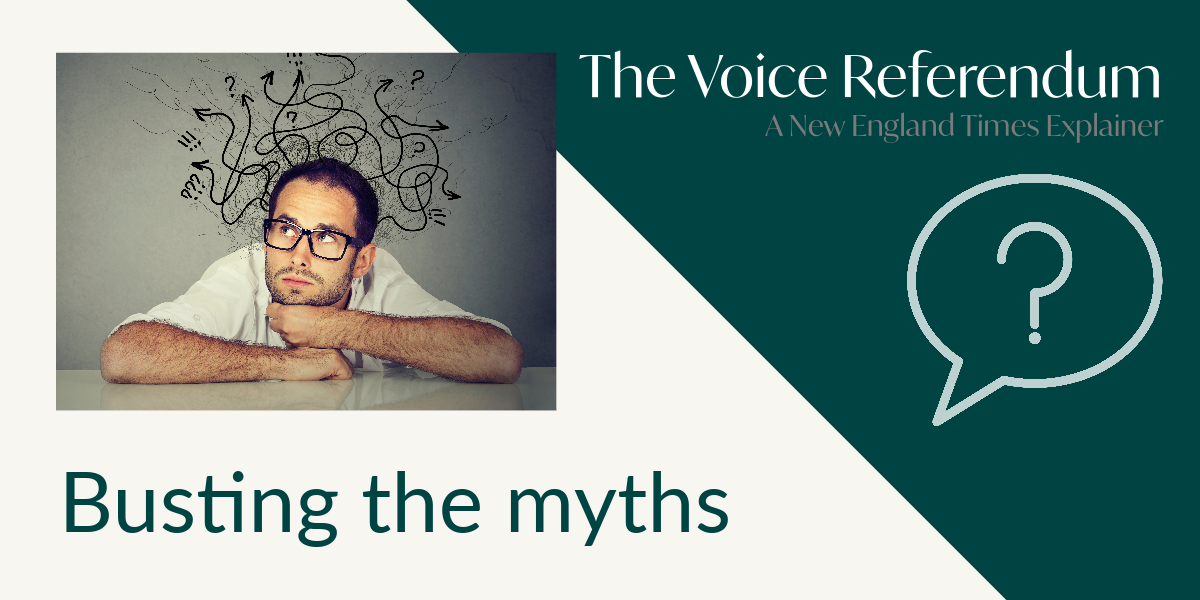We are having a referendum on October 14 to add some straightforward language to the Constitution, recognising Aboriginal and Torres Strait Islanders as the first people of this nation, and require that a body be established to represent them on laws that affect them.
Unfortunately, understanding what this referendum is about is not so straightforward, with many myths, misconceptions, and a lot of misinformation. Let’s debunk some of them…
If you want to have your say on the referendum, take part in our survey that closes tomorrow night September 30 at midnight.
Myth: ‘The Voice’ will amount to a third chamber of Parliament
What is proposed is a Voice to Parliament, not a Voice in Parliament. It will have no role in passing legislation; that will continue to be left to our elected representatives in the House of Representatives and the Senate, as currently prescribed by the Constitution.
The proposed Constitutional amendment states that the Voice body “may make representations” to Parliament. It will be up to Parliament to decide what it does with those representations. The proposed Voice to Parliament is a very conservative change to our Constitution.
Myth: It will be a lawyers’ picnic, and lead to lots of High Court challenges
How Parliament responds (or does not respond) to any representations made by the Voice would be non-justiciable – that is, it could not be subject to any court challenge. This is because the courts have always been reluctant to interfere with the internal workings of Parliament.
Myth: Voting Yes will not help to close the gap or have a positive impact on the lives of First Nations peoples
The Voice will provide advice to the Parliament on proposed laws affecting First Nations peoples. This should mean that Parliament will be better-informed about the impact of the proposed laws on First Nations peoples, and can change those laws to make them better. A better-informed Parliament is likely to lead to better laws that will have a positive impact on First Nations lives.
Even if that wasn’t the case, our nation voting No would have a negative impact on the lives of First Nations people, significantly setting back reconciliation and other efforts to combat racism. As we have seen in this week’s decision by Armidale Regional Council to recognise the Anaiwan people in welcome signage, recognition matters a great deal to lots of Indigenous people. So voting Yes, even if just to give that recognition, will have a positive impact.
Myth: The Voice will give First Nations peoples special rights
The Constitutional Expert Group comprising nine experts (including former High Court judge Kenneth Hayne) and chaired by the Commonwealth Attorney-General has advised that a First Nations Voice will not give First Nations peoples special rights. All Australians have the right to make representations to Parliament, which is guaranteed by the constitutional Implied Freedom of Political Communication. The First Nations Voice is simply a permanent one.
Myth: This will destroy our democratic value of ‘one vote one value’
There is no part of this proposal that has ever suggested Aboriginal and Torres Strait Islanders would have more than one vote in elections, or that their vote would be worth more.
Myth: There is no detail in the referendum, and if you don’t know, you should vote no
The referendum is only to change the constitution to recognise First Nations people and ensure that they always have a representative body to make sure they are consulted on laws that affect them. It is a very simple and conservative change, and it is normal for the Constitution to only include the framework, with the detail left up to Parliament.
There is a detailed report that sets out what a the Voice body could look like, for those who want the detail: Indigenous Voice Co-design Process Final Report. If you don’t know, and you want to know, read the report.
However, the actual detail is subject to further negotiation in the parliament, and most voters do not want nor need the long documents. It’s an easy line, but putting the burden of getting informed on really detailed and technical things on voters, when they don’t need to be across that detail and they have busy lives and more urgent things to be concerned about, is really inconsiderate and hurtful to average Australians.
Myth: There’s no need to enshrine the Voice in the Constitution.
As we covered in our last piece on the referendum, enshrining the Voice in the Constitution means it will not be able to be abolished at the whim of Parliament/the government, as every other body has been to date. It will also not be afraid to give frank and fearless advice. Its composition, powers and procedures will, however, be able to be amended by Parliament to ensure its effectiveness and as times change.
Myth: It will divide the nation
The ugliness of the current campaign is causing division, as all political campaigns do, and sometimes that is just a necessary part of making a collective decision. However, a Yes vote will be a big step towards reconciliation. A successful referendum on the Voice to Parliament will mean the Australian people have said that we want Parliament to listen to First Nations people, thereby signalling that we have accepted the invitation in the Uluru Statement from the Heart to walk together for a better future.
Myth: Indigenous Australians are divided over the Voice, therefore it shouldn’t be supported
Although there are some high-profile Indigenous Australians who do not at this point in time support the Voice (such as Jacinta Nampijinpa Price and Warren Mundine), a significant proportion of First Nations people do support the referendum. Additionally, it would be extremely odd if every single Indigenous person did support it, as individual’s political choices and opinions are not determined by race.
The vast majority of local Anaiwan, Kamilaroi, and Dunghutti people we have spoken to at the New England Times are in favour of a Yes vote, although, as is the custom of the peoples of this area to have deep respect for others, they often urge that you should find out for yourself what it is about and make your own decision.
Myth: Voting in the Voice referendum will be voluntary
Unlike the 2017 Marriage Law Postal Survey, in which participation was optional, the Voice referendum is as compulsory as voting in a federal election. All eligible Australian citizens aged 18 years and over are required by law to enrol and vote.
Myth: The AEC is rigging the vote by accepting ticks but not crosses
The correct way to vote in the referendum is to write the word Yes or No on your ballot paper.
There has been a lot of really unhelpful scaremongering about the normal way the AEC assesses votes that are not filled in correctly. Referred to as ‘savings provisions’ they are a set of rule to help poll workers count as many votes as they can. So, in a normal election, if a voter ticks or crosses a box instead of putting a number, or in this case writing a word, the poll workers can make the decision that the intent of the voter is clear, and count the ballot anyway. Crosses are harder for poll workers to assess, because it’s often not clear what the intention is – are they voting for that person, or crossing them out? This isn’t a bias towards either side of the campaign, it is a bias in favour of every voter having their vote counted.
Myth: we shouldn’t be adding anything about race to our constitution
Our Constitution already allows for racially discriminatory laws by virtue of s 51 (xxvi) (the race power). Further, the race power has only ever been used to make laws for Aboriginal and Torres Strait Islander peoples. So this referendum is not adding race to the Constitution – it’s already there – but it will improve our legal framework by ensuring that Aboriginal and Torres Strait Islander peoples are consulted when the race power is used to make laws that affect them.
Myth: The history of referendums in Australia means that it is likely to fail
Each electoral contest in the history of the world is unique, and what has happened in the past is somewhat irrelevant. But if past performance was an indicator, this referendum should pass easily: the most successful referendum in Australia’s history of referendums was in relation to Aboriginal people (1967). More than 90% of Australians voted ‘yes’ to amending two sections of the Constitution to ensure that Aboriginal and Torres Strait Islander peoples would be counted as part of the population, and that the Commonwealth would be able to make laws for them.
Myth: The polls say the referendum is going to fail
Polling is not predictive: it is a snapshot of a moment in time. Polls this close to any election are usually unreliable. When dealing with an emotive issue that is outside of the normal range of issues voters are asked to consider, there is always a high level of confusion and a high undecided vote right up to polling day, which makes polling more unreliable than usual. Even in normal elections, the polls in the 3 to 6 weeks before the election move around wildly. And while some pollsters adjust their numbers in various ways to make them more stable, the reality is that people will change their minds many times as polling day nears. Additionally, people who feel strongly about an issue are more likely to respond to polls, creating a bias in the results that is tough for any pollster to manage. The most accurate poll is usually taken about 6-8 months before an election, and all polls consistently pointed to a healthy Yes vote up until July.
Where to learn more about the referendum:
- For the nuts and bolts about how the referendum works, go to the Australian Electoral Commission’s site: https://www.aec.gov.au/referendums/
- The ABC Voice Referendum portal https://www.abc.net.au/news/voice-to-parliament-referendum
- The SBS Voice Referendum portal https://www.sbs.com.au/language/english/en/voice-referendum
- The Australian Government official website https://voice.gov.au/
- The main Yes campaign site https://www.yes23.com.au/
- There is a number of No campaigns, the main conservative No site is ‘Fair Australia’ https://www.fairaustralia.com.au/
- The Blak Sovereign Movement who are opposed to the referendum being held at all has their response to both the Yes and No cases at https://blaksovereignmovement.com/


